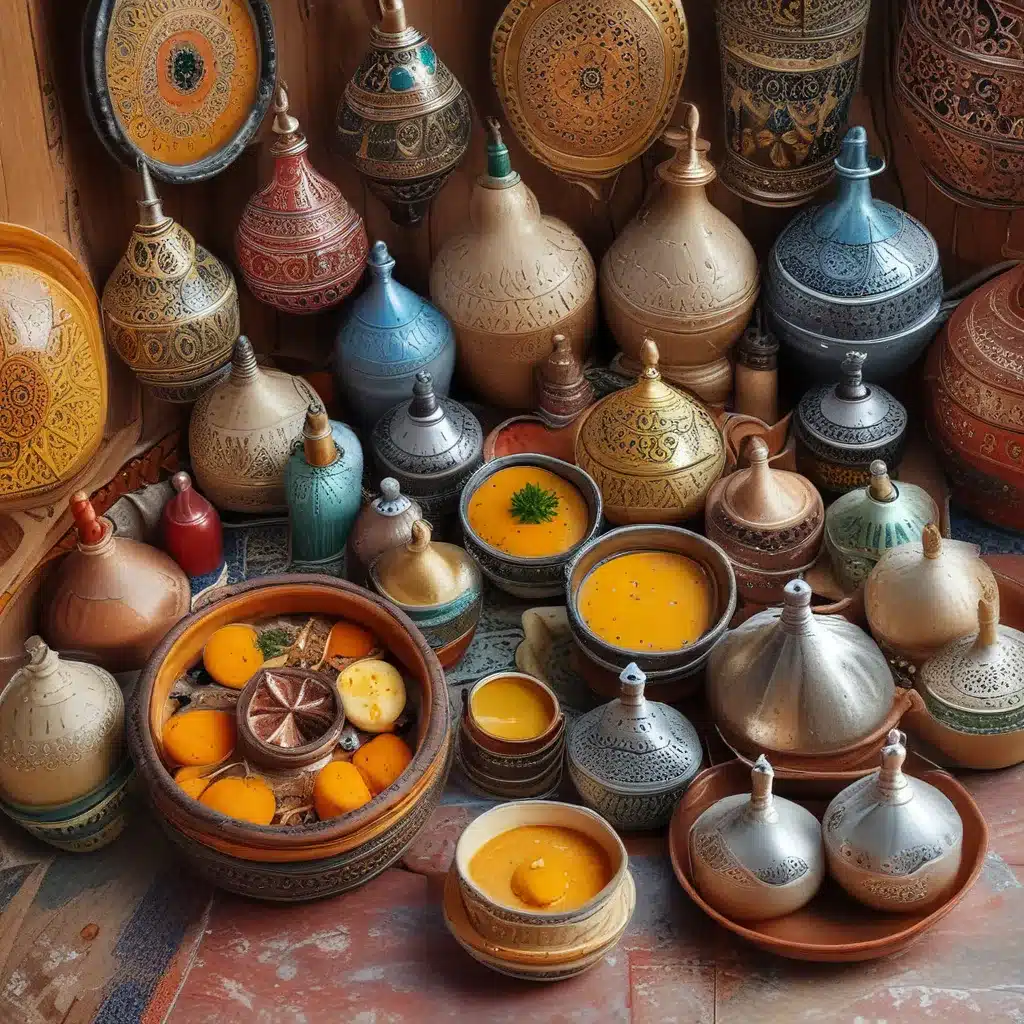
Unveiling the Mystique of Moroccan Kitchenware
As I sit in my cozy New York apartment, the scent of cumin and cinnamon wafts through the air, transporting me back to the bustling markets of Marrakech. Growing up in a family of Moroccan artisans, I’ve always had a deep appreciation for the rich culinary traditions of my homeland. And at the heart of these traditions lies the captivating world of Moroccan cookware and serving vessels.
The Allure of the Tagine
Every Moroccan kitchen is adorned with a collection of beautifully displayed tagine pots, also known as tajines or tangines. These distinctive clay vessels, with their signature cone-shaped lids, are the cornerstone of Moroccan cuisine. As a child, I can vividly recall the sight of my grandmother’s expansive tagine collection, each one a unique work of art.
Tagine pots are not just functional cookware; they are imbued with a sense of tradition and cultural heritage. The shape and composition of the tagine play a crucial role in the slow-cooking process, allowing the flavors to meld and the aromas to infuse the air. The cone-shaped lid traps the steam, creating a self-basting effect that results in tender, flavorful dishes.
But not all tagine pots are created equal. As I’ve discovered over the years, the composition of the clay used in their construction is of paramount importance. Natural clay tagines are the preferred choice, as they add a distinct richness to the flavors and allow the sauce to caramelize, further enhancing the overall taste.
The Art of Tagine Cooking
Cooking in a tagine pot is a delicate dance, one that requires patience and a deep understanding of the process. As a seasoned Moroccan cook, I’ve learned that sudden changes in temperature can be a tagine’s worst enemy. That’s why it’s essential to always cook on low to medium heat and never add cold water to a hot tagine, as this can lead to cracking.
The key to mastering tagine cooking lies in the preparation. Before the first use, the tagine must be seasoned to create a protective layer that prevents sticking and enhances the flavor. This involves filling the tagine with water, adding a few slices of lemon, and simmering it for several hours. Once the seasoning is complete, the tagine is ready to take center stage in your culinary adventures.
At El Bahia, our Moroccan restaurant in New York City, we take great pride in our authentic tagine offerings. From the classic lamb with prunes and almonds to the fragrant chicken with lemon and olives, each dish is a testament to the art of slow-cooking in these remarkable vessels.
Serving with Flair
Moroccan cuisine is not just about the cooking; it’s also about the presentation. Tagine pots aren’t just for cooking; they’re also used for serving, adding an extra touch of elegance to any table.
Glazed tagine pots, with their shiny surfaces and beautiful decorations, are the perfect compromise for both cooking and serving. They make a stunning centerpiece, drawing the eye and whetting the appetite. Unglazed tagines, on the other hand, offer a more rustic and authentic feel, perfect for those seeking a traditional Moroccan dining experience.
But the Moroccan tradition of serving doesn’t stop at the tagine. Small, colorful tagine pots are often used to present dips, sauces, and side dishes, adding a touch of whimsy and vibrancy to the table. These miniature versions are a common sight in Moroccan cafes and restaurants, and they’re a delightful way to engage all the senses.
The Essential Moroccan Kitchen
Beyond the iconic tagine, Moroccan kitchens are filled with a variety of essential cookware and serving pieces that are equally steeped in tradition. From the elegant Moroccan tea kettle used to prepare the fragrant mint tea, to the couscousière for steaming the fluffy semolina grains, each item serves a specific purpose and holds a special place in the Moroccan culinary repertoire.
One of the most fascinating aspects of Moroccan kitchenware is the attention to detail and the intricate designs that adorn these functional pieces. Many of these items are handcrafted by skilled artisans, who pour their hearts and souls into every creation. From the intricate ceramic plates and bowls to the ornate copper serving trays, each piece is a work of art that tells a story of Moroccan culture and tradition.
Bringing Moroccan Flair to Your Kitchen
As I reflect on my Moroccan culinary heritage, I’m reminded of the joy and connection that these traditional cookware and serving pieces can bring to any kitchen, whether it’s in Marrakech or New York City. The act of cooking and sharing a meal in a tagine pot, or serving a spread of Moroccan delicacies on a beautifully crafted tray, is a testament to the power of tradition and the enduring allure of Moroccan craftsmanship.
So, if you’re looking to infuse your kitchen with a touch of Moroccan magic, I encourage you to explore the world of Moroccan cookware and serving traditions. Whether you choose a classic tagine pot or a set of vibrant mini-tagines, these pieces will not only elevate your culinary experience but also transport you to the bustling markets and warm family gatherings of my beloved homeland.
At El Bahia, we’re proud to offer a curated selection of authentic Moroccan cookware and serving pieces, allowing our diners to immerse themselves in the rich culinary heritage of Morocco. So, come and join us on a delicious journey through the heart of Moroccan tradition, one tagine at a time.


